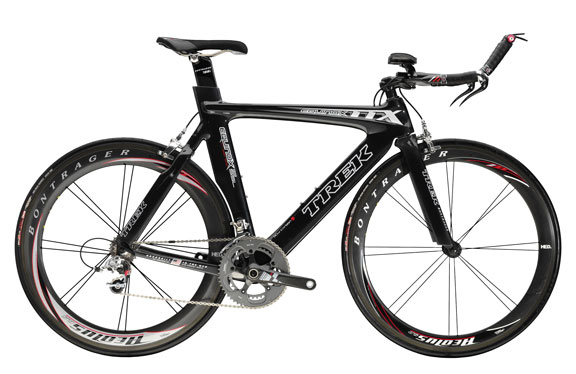Trek’s wind tunnel white paper

Trek Bicycle Corporation has granted Slowtwitch.com's readers transparency atypical in the bike industry. Trek's Damon Rinard has penned a white paper describing the protocol and results of a recent wind tunnel test that, among other things, compares its bikes to two others in its competitive set.
The white paper is downloadable as a pdf. References to this set of tests made its way onto the Slowtwitch Reader Forum, but they were lacking specificity. Correcting the misconceptions among Forum readers was the reason for the paper's publication, according to Rinard.
For the most part I'll let the paper speak for itself, but I will add a few of my own comments.
First, if the fitter who positioned that rider worked for me, he'd now be leafing through the want ads. The rider's ill-conceived position did not escape the notice of the folks at Trek, but they pointed out that the position — regardless of its appropriateness — was identical aboard each of the bikes tested.
The position was dictated by the Scott Plasma tested by Trek in the San Diego wind tunnel, according to Rinard (though the choice of the rider's saddle set-back must've been impacted by Trek's Madone, another bike tested). The Plasma's taller head tube mandated the rider's taller front end aboard all the bikes tested. That meant that the rider, when aboard a lower-profile bike, had to have that bike shimmed up to normalize the rider's position. I question whether a rider who is positioned higher and more rearward presents a fair test to a bike like Cervelo's P3C, which is made for a more forward rider with a flatter back and lower front end.
Furthermore, with a saddle height of 74cm and change the rider aboard the Plasma was probably riding a bike too big for him, even though it's a 54cm tested against other bikes in their 56cm sizes. That's the nature of that bike. Anyone who's ridden a variety of tri bikes knows that a 56cm Plasma is a lot "bigger" than a 56cm P3C, and a 54cm Plasma is still somewhat bigger. While the four bikes tested (the Plasma, Trek's Madone and Equinox TTX, and the P3C) were on paper of a similar size, you can't find two bikes more different than the Plasma and the P3C, both in size and in geometry. The tester aboard these bikes was destined to be too small for the Plasma, and too rearward and upright for the P3C.
What difference does this make, since the position was the same on all the bikes? I don't know. One way to tell is to perform the test with two or three different riders, set up in positions that are more appropriate for the bikes tested.
All that established, Trek's protocol appears sound. It differs from the protocol used by, for example, Cervelo, which last week tested its Zabriskie dummy aboard its bike with quick-change tube shapes. Fake-Zabriskie offers a greater degree of precision than Trek's live rider. But Trek's rider turns the cranks, whereas fake-Zabriskie doesn't.
Should Trek decide to replicate this protocol I'd like to see photos in profile of the rider aboard all the bikes. I'd also like to see a closer examination of apparent discrepancies, such as the differences in frame stack-plus-spacers that don't, on paper, quite add up. Finally, I'd like to see trials on more than one style of rear wheel. It seems likely that a disc tends to minimize the differences between various frames' abilities to fair the rear wheel.
In short, the test is valuable reading, because it's one of the few published examples of a company using a sound protocol. We thank Trek for publishing its test and look forward to more of the same from other companies.

